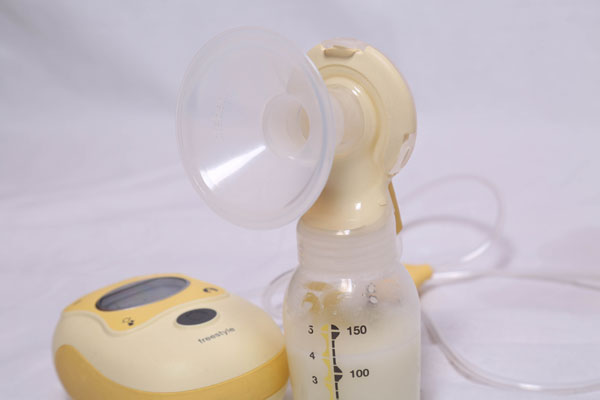Losing a baby any time after 16-18 weeks gestation may still lead to breast milk coming in to the breasts a few days later. This is because the arrival of milk is driven by the drop in hormones following the delivery of the placenta—irrespective of whether a mother planned to breastfeed or not. The presence of breast milk may not have been anticipated and a bereaved mother may find it very upsetting. While some women will want to stop lactation as soon as possible after stillbirth, miscarriage or loss of a baby, others may take comfort in pumping and donating breast milk. This article looks at the options to cope with lactation after stillbirth or loss of a baby.
Stopping milk production
To help bring milk production to an early end:
Express to comfort
The key to stopping breast milk production is to express just enough milk to stay comfortable and no more (express to comfort). This will avoid severe enorgement (breasts painfully full, tender and swollen with milk) and reduce the risk of inflammation of the breast (mastitis) while also sending a signal to the breasts to reduce milk production.
Use cold compresses
Cold compresses (e.g. frozen peas in a damp cloth or chilled cabbage leaves) held against painful areas of the breast for twenty minutes at a time can reduce any pain or inflammation. There is some evidence that cabbage leaves may be better than cool gel packs for reducing engorgement1.
Pain relief
Take pain relief as needed and as recommended by your health care professional.
Do not bind the breasts
Although suggested in the past, binding the breasts with tight cloths or wearing a very tight bra and never expressing any milk to stay comfortable has fallen out of favour as a way to reduce milk production.2 However, a firm, well fitted supportive bra can help comfort levels by supporting the breasts3. If engorgement is ignored it could lead to painful blocked ducts or mastitis (sometimes known as milk fever) which, if not treated promptly may require antibiotics or could lead to a breast abscess.
Some herbs may help dry up breast milk
Sage, peppermint, parsley and other herbs are thought to help reduce milk supply. Kelly Bonyata discusses how to take sage in Too much milk: Sage and other herbs for decreasing milk supply. Jasmine flowers on the breasts may reduce milk supply4, one study found nasal drops made from an extract of jasmine flowers contained a prolactin-lowering substance.56
Drugs to dry up breast milk
In the past prescription drugs such as bromocriptine and cabergoline were frequently used to dry up breast milk. These drugs work by interfering with prolactin secretion (one of the hormones needed for producing milk) but can have some undesirable gastrointestinal, cardiovascular and neurological side effects.
- Bromocriptine is no longer recommended as a lactation suppressant in some countries due to several maternal deaths, seizures and strokes.78 The World Health Organisation says:
Bromocriptine inhibits prolactin secretion, and can be effective if given early in lactation, while prolactin levels are high. However, it may be less effective after some weeks when prolactin levels are low. It has been withdrawn from use for this indication in several countries because of the risk of myocardial infarction, hypertension, seizures and strokes. Other side effects reported include nausea, dizziness, hypotension, and severe headache.
- Cabergoline (trade name Dostinex) can have some side effects such as nausea, headache, palpitations and dizziness9 but it is considered safer than bromocriptine10. A recent review of the effectiveness and safety of cabergoline concluded it is generally safe and effective for suppressing lactation although careful consideration of risk and vigilance is needed.11
Hormonal birth control pills and certain decongestant medication (containing pseudoephedrine) can also reduce a milk supply in some cases. For further information about using any of these drugs to dry up breast milk consult with your doctor.
No evidence for drugs in preference to other measures
There is no evidence that using drugs to dry up breast milk is any more effective than methods that don’t involve drugs such as expressing just enough milk to be comfortable.121314
Further information
For further information about stopping milk production after infant loss see:
- Lactation Suppression, Australian Breastfeeding Association, 2020
- Lactation after Loss: A Guide for Bereaved Mothers, Empty Arms Bereavement Support, 2010
Donating breast milk after loss
If a mother is interested in pumping and donating breast milk she can find her nearest milk bank in the United Kingdom at United Kingdom Association for Milk Banking (UKAMB) and in North America at Human Milk Banking Association of North America (HMBANA). Monique’s story of milk donation may be helpful; Freya’s Gold: Milk Donation After Loss (Lactation Matters, ILCA).

As long as pumping milk from the breast continues, breast milk will continue to be made to replace it. When a decision is made to stop donating milk, it is best to gradually pump less often and for shorter pumping times over a period of a couple of weeks. In this way the breasts will adjust naturally so that the production of breast milk can come to a gradual end without engorgement.
Support organisations
- Internationally; International Stillbirth Alliance; find member organisations by Country.
- In United Kingdom; Sands—Stillbirth and Neonatal Death Society offers support by telephone, email and forums.
- In United States of America: Share Pregnancy & Infant Loss Support.
There are many other support websites that a bereaved mother or her supporters may find helpful including Glow in the Woods and Still Standing Magazine.
Summary
To stop lactation after miscarriage, stillbirth or infant loss, express just enough milk to stay comfortable by hand expressing or using a breast pump—the milk supply will gradually reduce. There is no evidence that using prescription medication to dry up breast milk is more effective than expressing to comfort. Some women choose to pump their milk and donate it to a milk bank.